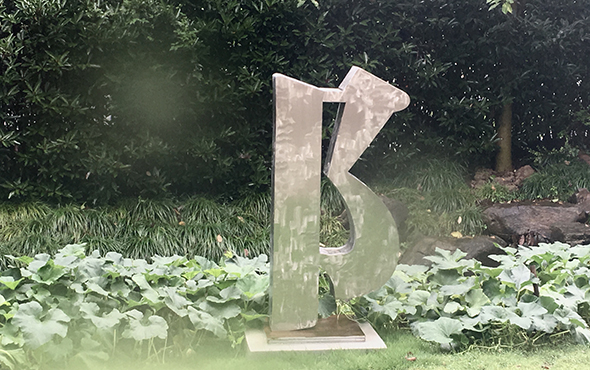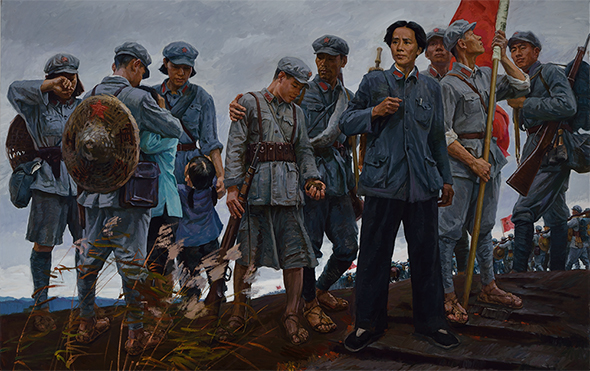
Reflection of Red Well, 2016; Collective Creation by the School of Architecture, 650x800cm
The School of Architecture becomes an important force in the “Relay” exhibition, first of all, it is the return of architecture as art. As early as the first century BC, Roman architect Vitruvius proposed three criteria for architecture in his classic masterpiece “De architectura libri decem”: solid, practical and beautiful, from then on the artistic property is one of the essential attributes of architecture that has affected later architectural development. However, with the advent of the industrial revolution of the 19th century, the idea that architecture was a living machine became fashionable and modernism which advocated functional supremacy swept the world. The practical attribute of architecture completely suppressed the artistic attribute of architecture. On the one hand, the extreme idea led to the constructional materialization of buildings, and on the other hand, it also led directly to the same images of the city across the country. Therefore, the School of Architecture participates in the Relay exhibition that gave first place to the traditional modeling disciplines such as painting and sculpture and reveals the return of the artistic property of architecture which has been suppressed for a long time.

Listening, the Sound of Wind, 2016, Stainless Steel, 150x40x20cm
I think the School of Humanities should have a closer relationship with other faculties of plastic arts and design art because it is a school of humanities located in the overall structure of the Central Academy of Fine Arts, the evaluation of artistic phenomena should be applied by other faculties in the process of the creative practice, offering their artistic creation to the content that can be used for reference, thus narrowing the distance between theory and practice. If the teachers and students only bury themselves in books, instead of being concerned with the creation of other faculties, nor participating in the activities of the whole school, on the one hand, it leads to the limitation of horizon and being short of the capability to include the problems of other professions and disciplines into the theoretical thinking. On the other hand, it will lose the congenital advantage of the School of Humanities in the school of fine arts. In addition to the theoretical and practical form, the mutual reference and confirmation, we can also cooperate with other faculties to carry out academic research, to increase opportunities of cross-disciplinary exchanges, and then promote the development of our own disciplines.

The Tradition of Long March goes down generation by generation
Art education is included in the creative activities of the “Long March of Art”, which is the biggest new idea in my opinion. Through the active organization and planning by the teachers and students, we hope to allow art education to penetrate into the lives of ordinary people. The Institute of Arts Administration and Education at CAFA sent a team of teachers and students to the Zoige County, Aba Tibetan District in Sichuan during the creative events of the “Long March of Art” in September. We visited a number of primary and secondary schools in the Tibetan areas, and organized the thematic activities related to art education, and collaborated with children to create on the theme of the “Long March of Art”. In the creative process, the team also used a number of high-tech performance techniques, such as VR shooting and production, etc. In my opinion, the “Long March of Aesthetic Education” is sending art education to the Long March.

Wang Hanying, Farewell to the Soviet Area
The national rejuvenation is based on the common achievements of the material civilization and spiritual civilization, in the past, our works focused on economic construction, while the state will also heavily grasp the culture as it did the economy, taking the mission of the great rejuvenation of the Chinese nation as the supreme mission of literature and art. The nation is not an abstract concept that today’s people are people of flesh and blood. Today’s people are of the times, the great times of the people; literature and art serves the nation, in the context of the times it is centered on people including all classes and all people of the Chinese nation, which is a people-oriented concept starting from the national position. It is a great era, an epic era, the times creates heroes, the times are full of moving stories. It re-calls the heroism in this era, and it does not lack great stories that touch the heart, as the artists of CAFA, we should be able to perfectly tell the stories of the Chinese people.

Ma Gang, Don't forget your original intention, 2016; Oil on canvas, 150x150cm
In the creation of historical paintings, first of all, it is necessary for the creator to have feelings, knowledge, interests of the subject of their paintings, and to go to the scene to sketch, in order to establish a feeling for the painting. The creation of historical painting seeks a sense of history, which is a perception of this history, and the perceptions of the characters and scenes in the history. The feeling comes from the imagination, coming from the research of painting materials, coming from the sketch, coming from the repeated use of a brush to examine, to study and portray characters. When a creator gets the feeling, he needs to constantly pay attention to it and keep it. Finally, the creator needs to think of how to transform his feelings into objects that can be accepted by the audience, making the creation a meaningful work.
Translated by Chen Peihua and edited by Sue/CAFA ART INFO




























